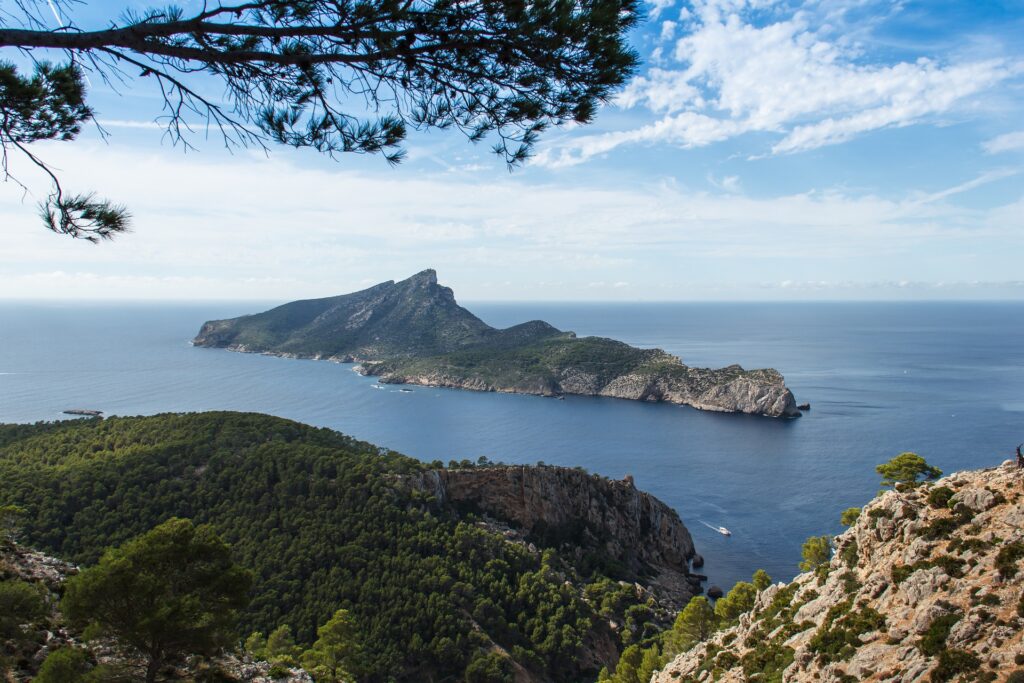Serra de Tramuntana, the other Majorca

Preserved by a steep relief, this region of the northwest coast of Mallorca has kept a delicious authenticity. A balcony on the Mediterranean, lined with olive trees, orange trees, turquoise coves and picturesque villages.
“Everything that the poet and the painter can dream, nature has created in this place”, wrote George Sand. The story is famous. Winter of 1838-1839. The writer and his lover Frederic Chopin visit Majorca. The couple settled for a few months in the heart of the Serra de Tramuntana mountain range, in the Carthusian monastery of Valldemossa. In this place, Sand recorded the memories that she would publish in Un hiver à Majorque (A Winter in Majorca), a travelogue that Mallorcans have forgotten the long diatribes against their ancestors, in favor of lyrical flights of fancy about the magic of the landscape. Still miraculously intact today. Bartomeu Deyà, the representative of the Consorcio Serra de Tramuntana, is grateful to her: “George Sand, we adore her, she is the best ambassador of Mallorca of all time, she is the one who made discover our island to the travelers and she is the one who sings best the natural beauties of the north coast; this other Mallorca. Another Mallorca”, spared from the excessive construction and the hated mass hotel business.
From Palma airport to the village of Valldemossa, it takes only about 20 minutes by car. The buildings fade into the agricultural plain. Then appear fertile valleys, delicate as watercolors. The hillsides, scarified by sinuous horizontal lines drawn by dry stone terraces, reveal a patchwork of lush orchards. When Unesco classified the Serra de Tramuntana as a World Heritage Site in 2011, the impressive work of man in taming nature was chosen as a criterion of exception. And transform it into a huge garden, testimony of secular exchanges between Muslim and Christian cultures in the Mediterranean basin. When the Moors conquered Mallorca in the tenth century, they created an articulated irrigation and water supply network, as well as stone walls to counteract the steep morphology of the terrain. They made of this rough land a vegetable garden-orchard, very beneficial for the islanders.
Then, in the 13th century, the Christian conquerors, new masters of Majorca, introduced a system of territorial control. The picture of the Serra de Tramuntana is sketched: churches and monasteries, lighthouses and watchtowers, fountains, ponds, olive groves, orange groves, lemon groves, vineyards … exploited by large farms of feudal origin, the posesiones, of which there are still many remains scattered in the Serra. Around, an immense forest of oaks, pines, cypresses… And in the middle, lakes and icy torrents. A paradise for hikers.
Along the backbone of the Serra, following the MA10 road, a string of wild capes and picturesque villages stretches. Valldemossa, famous for the stay of its illustrious guests in the Reial Cartoixa, this disused Carthusian monastery, former residence of King Sancho, built for his son by Jaume II in the 14th century. At its feet, a maze of cobbled streets, stone houses with flowered balconies, an interlacing of gardens. Wild or cultivated. Sometimes invaded by a herd of goats or sheep. And everywhere, as soon as the breeze rises, the enchanting scent of orange trees in bloom. A few kilometers below the village, a tiny turquoise cove surrounded by jagged cliffs. The same scenery, the same bucolic scenes, in Bañyalbulfar, the medieval village draped in vineyards, or in Deià, the city of artists. Refuge of predilection of the writers and the stars of cinema. If Michael Douglas settled in Valldemossa – he even opened a cultural center there, which is now run by the Council of Mallorca – previous generations – from Picasso to Anaïs Nin to Ava Gardner – put down their trunks in Deià. An exquisite postcard setting, where we meet many more visitors than locals. Except maybe around the church, where some matrons, sitting in front of their door, sell directly their homemade jams of oranges and lemons.
To experience the quintessence of Tramuntanese life, the best place to stay is in Constitution Square in Sóller. Between the Sant Bartomeu church and the Art Nouveau building of the Central Bank, whose facades were designed by Joan Rubió, a disciple of Gaudí. Under the shaded terraces, the old people are re-enacting the world while waiting for the young people to come back from the beach in a vintage tramway – a museum piece, which will celebrate its centenary in October. When asked about what has changed in the last twenty years, Bartomeu answers: “Nothing! That’s why we fought to have the region classified by Unesco. So that nothing changes! This feeling of permanence, of timelessness, even of eternity is felt better than anywhere else in the delicious gardens of Alfabia where, in a lush plant decor, the melody of the fountains mingles with that of the birds. We can understand Gertrude Stein’s words to the poet Robert Graves when he announced that he was going into exile in the Serra de Tramuntana. “If you are able to handle such an intensity of heaven”…■
